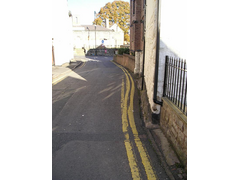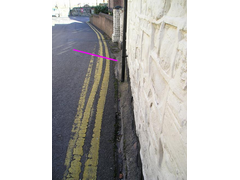locoboy
|
| posted on 7/11/07 at 11:34 AM |

|
|
Road side drainage issues
Hi Guys,
Im wondering if anyone can shed any light on this situation for me..........
part of my house is right on the roadside with no pavement between my property and the road itself.
Due to the camber of the road i end up with a pool of water collecting against my house wall.
The bottom of this wall inside the house is all damp and sometimes has dark deposits on it too.
It is not a modern brick wall, it is made of stone - what type im not sure but this part of the house is believed to have been erected in 1690, so no
modern damp courses etc. the inside of the wall is painted stone too.
The picture below shows the road and the wall in question.
There a very positive camber well maybe that the wrong word because the road jus plain slopes from left to right, thus depositing run off from the
road up against my house.
There are no kerbside water drains on this section of the street at all. Admittedly i have a downpipe running straight down to the problem area but i
left a bucket under that for a couple of weeks and it made little difference o the amount of water that collected against the house as it only
collects water from about 3 sq meters of roof.
I do plan to divert the downpipe to join into the one in the foreground on the corner of the house which runs into the underground storm drain.
My question is, are the people responsible for highway drainiage at fault for not having adequate road surface drains to divert the water away from
coming to rest against my house.
 
roadside1
This picture below shows it in more detail and the line shows where most of the water pools, which also corresponds with the dampest area of the wall
inside the house.
 
roadside2
The concrete benching (concrete that has been laid up against the house to attempt to keep the water away at a guess) has broken up in places, but so
has the road surface, so repairing or replacing the benching would not achieve much if the surface i am laying it on is not watertight.
Any ideas on places to start / call or things to do to lessen the damp inside the house?
any pointers or advice much appreciated.
ATB
Locoboy
|
|
|
|
|
designer
|
| posted on 7/11/07 at 12:06 PM |

|
|
Initially, contact the local council and talk to them to see who's responsibility it is.
|
|
|
MikeR
|
| posted on 7/11/07 at 12:19 PM |

|
|
I'd expect most of that water to run down the hill (at least it looks like its got a hill to run down to me)
|
|
|
locoboy
|
| posted on 7/11/07 at 12:28 PM |

|
|
It does run away from the camera but the left to right slope is steeper and therefore most of the rain makes itsway across the road rather then down
it.
There is a low point right at the end of the house where it pools, this is where the road surface/benching is at its worst too, probably due to
pooling then freezing etc over the years.
ATB
Locoboy
|
|
|
RickRick
|
| posted on 7/11/07 at 12:32 PM |

|
|
i think you need to get the drain off your roof moved first, as soon as a concil type comes to investigate for you, he'll blame that, since
it's the cheapest and quickest solution for them
|
|
|
locoboy
|
| posted on 7/11/07 at 12:43 PM |

|
|
I appreciate your comment RickRick, and i will do it as soon as i can although all of the other houses have downpipes that drain into the ground on
the pavement, there is no grate as such it just goes straight into the ground and presumably into the storm drain underground.
Until recently when i had drainage work done within my property boundary i did not have the ability to connect to the storm drain in any way.
So for many many years it would seem that my house has had to spew its water onto the road or within the confines of my property boundary, therefore i
(would) have had no choice but to empty it onto the road and with no adequate roadside drainage then the problem would be as it is
now...................
If you get what im saying 
Eitherway i will get the pipe re routed this weekend.
ATB
Locoboy
|
|
|
speedyxjs
|
| posted on 7/11/07 at 03:40 PM |

|
|
As already said, get the pipe sorted and then try the council but they will probably try everything they can to wiggle out of it so make sure you are
prepared for what they might ask 
How long can i resist the temptation to drop a V8 in?
|
|
|
DarrenW
|
| posted on 7/11/07 at 04:08 PM |

|
|
It looks like there is the remains of a gulley almost visible that is now partially covered by the road being resurfaced more than once. Maybe the
gutter signifies that the council or road people have a responsibility for surface drainage.
Is it possible that some resurfacing work has blocked a gutter and some chipping away might allow the surface water to run away a touch?
|
|
|
locoboy
|
| posted on 7/11/07 at 04:22 PM |

|
|
Unfortunatley not,
The gully has been made by the looks of it by pushing a length of guttering into wet concrete, then removed to leve a channel.
This has broken up a bit too further along the wall.
It looks like an attempt to trap the water at a distance from the houe and move it on quickly as opposed to letting it sit up against it.
ATB
Locoboy
|
|
|
DarrenW
|
| posted on 7/11/07 at 05:57 PM |

|
|
Do you know where the levels sit? I wounder if you can add more concrete to take away the dipped bit (just depends if it would require concrete half
way across the road or not).
Is the conrete bit on side of wall your land or the highway? Just wondering if you could fit a drain or not into existing storm drain. It will cost
but maybe less stressfull than trying to get council to act.
Where does the down pipe go that is in middle of the wall?
I bet the problem is made worse when cars go through the puddle as it will splash up the wall.
[Edited on 7/11/07 by DarrenW]
|
|
|
locoboy
|
| posted on 7/11/07 at 07:25 PM |

|
|
Darren,
The downpipe in the middle of the wall just exits onto the ground.
The puddle isnt big enough for cars to splash through but its bid enough for me to see that its not good having it there!
ATB
Locoboy
|
|
|
DarrenW
|
| posted on 7/11/07 at 07:55 PM |

|
|
I had an old stone cottage once with similar down pipe and a front garden that sloped towards house. Always had damp bits in front wall. I dont think
the house had founds - built on bed rock. Defo no damp proof course. I managed to control the damp by re-directing the down pipe, digging a 12"
wide approx 2' deep 'trench' in front of wall, membrane behind and filling with concrete. Just in front of this placed a land drain
full length of the house running into a deep soak away that i also had dug for the purpose. It didnt solve it 100% but did improve it a lot.
I know this cannot be done in your case but may give some inspiration.
Worth contacting the council first. I cant help thinking that several resurfacing jobs have made the situation worse for you.
|
|
|













